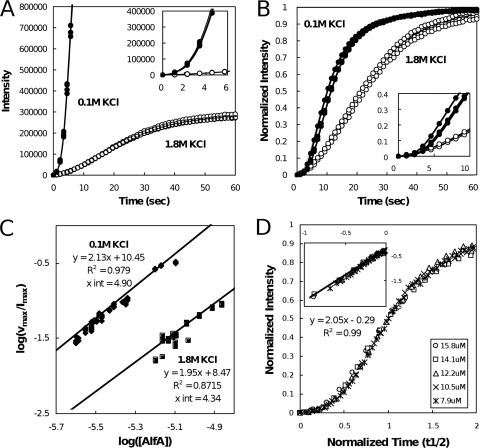FIG. 4.
Light scattering in high-salt conditions. (A and B) Assembly of filaments in the presence of 5 mM ATP and 0.1 M KCl (filled circles) is more rapid than assembly of filaments in the presence of 1.8 M KCl (open circles). (A) At identical instrument settings, assembly of 3.8 μM AlfA in the presence of 0.1 M KCl quickly saturates the detector, while the signal for 7.4 μM AlfA in the presence of 1.8 M KCl remains modest. Both concentrations of AlfA are approximately 1 μM greater than the critical concentrations for the relevant KCl concentrations. (Inset) Early time points. Otherwise, the conditions were the same as those described in the legend to Fig. 3A. (B) Intensity-normalized traces obtained with similar instrument settings, showing that polymerization is slower in the presence of 1.8 M KCl. The conditions were the same as those described above for panel A, except that 0.1 M KCl was used with 3.1 μM AlfA. (C) Determination of nucleus size and relative nucleation rates for AlfA in high- and low-salt conditions. To generate a data point, the maximal velocity of a light scattering trace (vmax) was divided by the maximal intensity of the signal (Imax), and the log of the resulting value was plotted against the log of the AlfA concentration. The slopes of the regression lines are proportional to n/2, where n is the number of monomers required to form a nucleus. This analysis suggests that AlfA assembles with a nucleus size of four monomers in the presence of both 0.1 M KCl and 1.8 M KCl but that the nucleation is approximately 10 times faster in low-salt conditions. (D) Data collapse for light scattering traces obtained with 1.8 M KCl using various concentrations of AlfA after normalization of maximum intensities and half times (t1/2). (Inset) Log-log plot of the same data, showing that the slope of a regression line is 2. The conditions were the same as those described above for panel A.

